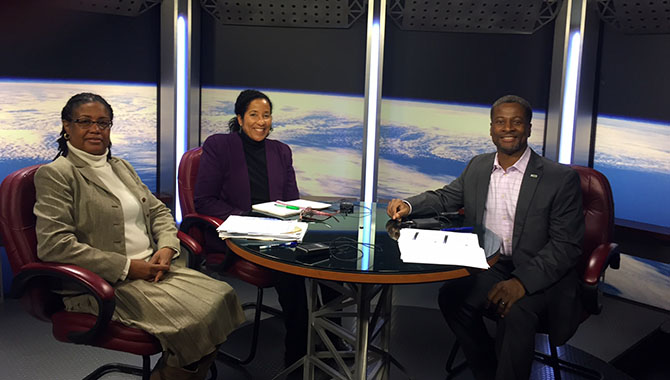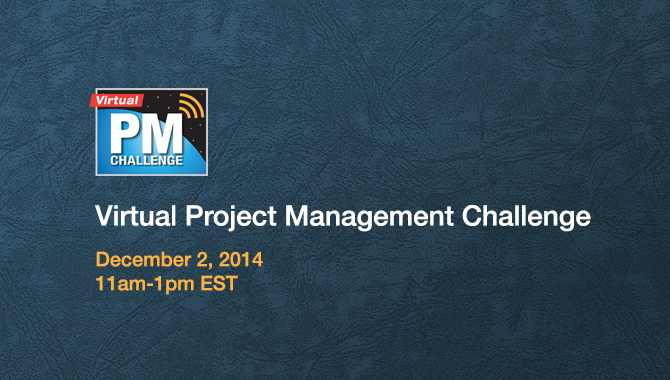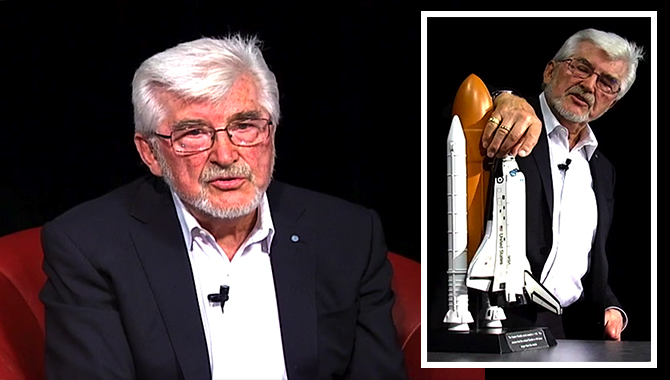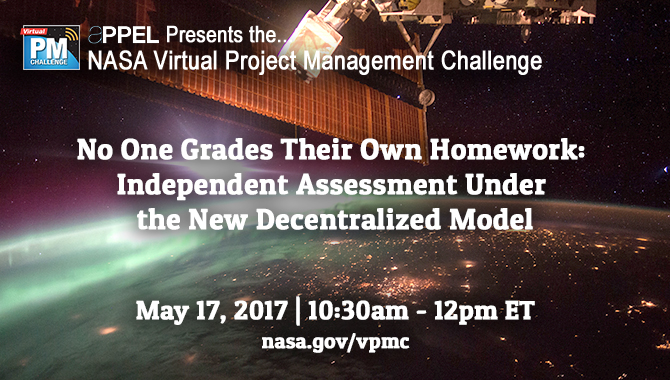
Presenters Vernell Jackson (left), Systems Resource Manager in the Applied Engineering and Technology Directorate at Goddard Space Fight Center (GSFC), and Cynthia Simmons (center), Associate Division Chief of the GSFC Instrument Systems and Technology Division, talk with Virtual Project Management Challenge moderator Ramien Pierre (right) about how to get a project back on track with schedule and cost.
Photo Credit: NASA
In a recent Virtual Project Management (PM) Challenge, Cynthia Simmons and Vernell Jackson discussed how they rescued a project that was over budget and behind schedule.
At Goddard Space Flight Center (GSFC), NASA developed an advanced instrument featuring never-before-flown technologies for ASTRO-H, a Japan Aerospace Exploration Agency (JAXA) facility-class mission now known as Hitomi. On February 17, 2016, that instrument—a high-resolution Soft X-Ray Spectrometer (SXS)—rocketed into orbit, as part of Hitomi, atop a JAXA H-IIA from Tanegashima Space Center in Japan. But five years before the successful launch, no one was certain whether the instrument would be built at all.
In 2011, the project was in trouble. It was over budget and behind schedule, and in grave danger of being cancelled. Simmons, Associate Division Chief of the GSFC Instrument Systems and Technology Division, was brought on as instrument manager to get the project back on track. She took the novel step of seeking out a business manager who could join her in finding solutions to save the project by reining in out-of-control costs and firing up the lagging schedule. That partner was Jackson, Systems Resource Manager in the Applied Engineering and Technology Directorate at GSFC.
During the Virtual PM Challenge in February, Simmons and Jackson talked about how they worked together to change behaviors in order to create a high-performing project team that could accomplish the near-impossible: complete and deliver the NASA SXS hardware to JAXA as promised. The Virtual PM Challenge, Project Derailed? Get Back on Track with Schedule and Cost, is now available to view online. After their presentation, APPEL News caught up with the partners to learn more about the challenges they faced and the solutions they put in place.
APPEL News: Cynthia, during the Virtual PM Challenge, you mentioned the importance of getting to pick the people you brought in to help recover ASTRO-H. Why was it important to you to pick your business manager?
Cynthia Simmons: In a situation like ASTRO-H, usually they just assign a resource analyst: someone who does the financial reporting that a project needs to provide for all the agency and monthly Goddard financial reporting. Whereas that function is important, I didn’t want someone just assigned; I wanted to outline the skillsets I needed and for them to fill the spot according to those specifications. Specifically, what I was looking for was someone on the financial side who was more of a business manager, someone who had enough background to be able to strategize from a business perspective. The reason that was important was because I knew there were so many facets of ASTRO-H that I had to get a handle on in a very short amount of time and it was too much for me to do it all.
APPEL News: So you knew right from the start that this business manager was going to be your partner to resolve the situation with ASTRO-H?
Simmons: Yes, and that goes back to something I said in the Virtual PM Challenge about the three-legged stool. That’s a model from my industry experience where the project manager has two partners: the business manager and the systems engineer. They are the Chief Financial Officer and Chief Operating Officer of the project, and the project manager is analogous to the Chief Executive Officer. It’s the approach I’ve always used, though it’s not the approach that’s used here at Goddard. But I knew it was the approach I had to take in order to recover that instrument. So I already knew which skillsets the business manager needed. I asked for that, and I got Vernell.
APPEL News: Vernell, when you joined the project, were you confident the two of you and the team could turn things around?
Vernell Jackson: Once Cynthia asked me to work with her on ASTRO-H, I believed that we would get it back on track. As you heard in the Virtual PM Challenge, Cynthia said, “It’s going to hit the mountain.” But that didn’t matter to me. I felt really confident we could do it anyway.
APPEL News: Both of you talked a lot about the importance of building trust in order to turn a project around. Why is trust so important?
Simmons: I call it fueling the engine. People will give 100% out of fear of being fired. But they will give 100-plus percent when they believe in what they’re doing and feel valued.
I am known for being tough because I have high expectations. But I don’t put people in positions that magnify their weaknesses. This enables them to meet my expectations because I’m leveraging their strengths. Then I reward them by writing kudos to formally document the contributions they have made with their supervisors and managers. As a result, they know that their contributions are valued. It gets them to be creative, to look beyond and see other problems and be proactive in dealing with them. So that’s an engine you can fuel—and that’s how you develop trust and have a high-performing team. My goal is to get the most effective team. You don’t have to like me, but I want you to come to work professionally and do your job so we can work together as a team.
Jackson: The importance of winning people’s confidence really gets to the point of being a business manager or the person who has oversight of the budget. Since NASA is a technical organization, the passion here is about the engineers and scientists achieving their goals and dreams of creating and innovating and finding the answer to the question, whatever it may be. The engineers and the scientists don’t want any impediments to achieving their goals and objectives. They want to get the job done. On ASTRO-H, one of the things I wanted to make sure that the Product Development Leads (PDLs) or sub-systems leads understood was that there is a benefit to be gained in working with me. Because I was a resource with a varied background and had worked in several positions for NASA and Goddard, I knew I could help them navigate through the working relationships with developing and testing an in-house instrument and/or hardware. I wanted them to look at me as a resource, not as an impediment to getting their job or their mission accomplished.
So I had to be honest with them and let them know exactly what benefits they would gain in working with me—and what they would stand to lose if they didn’t. At first, if I wanted them to look at new way of doing a procurement, they were a little leery because they were used to doing it in a particular way. But if they could see the benefit of doing it another way, which could help them meet their schedule milestone and meet their requirement, then we could minimize some of their concerns and establish a good working relationship between the PDLs and me. And of course, the choice—whether to do it their usual way or the new way—was theirs. Again, if they could see the benefit beforehand, and then if the benefit actually occurred, I gained their trust. That made them more willing to work with me. So if later I said, “We don’t approve the funding for this,” there was a bit of an understanding. We were on the same page. Because we had the same ultimate goal, which was to deliver hardware.
It was a very huge thing to win the trust. By doing that, we could decrease the number of meetings we had to have, and the team started feeling really good about what they were doing because they were making progress, and we could show that progress to management, and then management of course felt very good about the team.
APPEL News: What was the biggest challenge you faced in getting ASTRO-H back on track?
Jackson: I talked with Cynthia about this. We did soo much that we really can’t come up with just one thing we did. But when I look back, to me the biggest thing that helped me was the probing. I had to get to the bottom of why we were spending so quickly but had little hardware built. There were those who felt I was digging too much or too deep and were not as cooperative initially, but once they understood how I could help the instrument manager and team get back on track, the barriers to information and negotiation started to come down. I wanted to figure out where these funds were going and whether it was appropriate to be spending in that fashion. It’s okay to spend. But I wondered if there was another way we could do it. So I think my biggest challenge was finding out where we were: really assessing it, analyzing it, and then coming up with a strategic way of accomplishing what we were trying to accomplish with the budget that we had. And showing management that we could build and deliver the hardware within the budget for the cost cap mission. We had to manage the spending on the team, and we had to manage the expectations of management about what the team could do.
Simmons: I don’t think I can narrow it down to one thing. There were several big things. One was the team dynamics. The team was very fractured at the time. There were personality conflicts, which created cliques. And there were dynamics between disciplines. That was going on at the same time as what I called, in the Virtual PM Challenge, the “hostile takeover.” This change in project management—from the outgoing project manager to me—was not something the team voted on. So gaining their trust was one of my big obstacles.
Then the other big obstacle was simply that we were over budget and behind schedule. And Headquarters said this was a cost cap: We’re not giving you any more money. So I had to win Headquarters’ trust, too, and get them to see that they were going to have to pay more. The equation wasn’t either cancellation or fit-it-all-in-the-existing-budget. The equation was either you cancel it or you continue and stretch the money as far as possible—but you will need to find some more money to finish it.
APPEL News: Cynthia, in the Virtual PM Challenge you emphasized the need to change team behaviors to get your project back on track. Why was that important, and what’s a tool you used to accomplish it?
Simmons: Very simply: if the team didn’t change their behavior, there was no way we were going to turn the monthly burn rate into a sustainable burn rate. No way. So that’s why I had to get them to change their behavior. What I had to get them to see was why it was important to change. And that was very tough.
In a crisis—because that’s what we were in—many people think you need a dictatorial leadership style. “You will do this because I said to.” I did that in my early career, and learned that what you get in return is the bare minimum of what you want. Because people will do whatever it takes to not get fired, but they won’t go the extra mile to turn something around if you treat them that way. So you have to use other types of leadership styles.
The project manager really needs to have, as their resource, different leadership strategies. They need to get the training, mentoring, and coaching to help them leverage the right approach on their project at the various stages. I think a lot of time people have one certain leadership style, but that may not fit for every project, or be right at all stages of a project. To get the highest-performing team, not only does the team have to come along with you, but the leader has got to be flexible in their style. Unfortunately, I see a lot of project managers—I’ve worked for a lot of them—who learned a certain way of leading and they just proceed with that. And sticking with that one way doesn’t produce the highest-performing team.
APPEL News: Vernell, you said you asked three particular questions over and over to get results. One was “What are we paying for?” Can you tell us how much you ended up saving the project by asking that question?
Jackson: I don’t know what the total savings were because I left the team before the end. We decreased the number of support service contractor tasks from 33 to 19, and we reduced the contractor manpower monthly accrual from roughly one million to roughly 400,000 dollars. So that was a great achievement, since it illustrated the progress of cutting and controlling spending and costs. We started in March 2011, and by July of 2011 we had cut the burn rate from about approximately $1.8 million to about $900,000. That meant we could continue spending within our budget allocation for that fiscal year. And so by the time fiscal year 2012 rolled around, we were able to forward-fund our contractor support. The continued due diligence in cost control processes allowed the team to yield an additional savings of approximately $1.4 million. We were still cutting costs and controlling costs, allowing us to have about $4.4 million carried into fiscal year 13, which gave us the opportunity at that time to complete the hardware that Goddard had committed to doing for delivery to our international partner, JAXA. Once I identified the sources of what we were paying for and addressed those sources with a new strategic and tactical plan, we could see the progress in managing the funding, and we could also see it in the technical progress.
APPEL News: If the audience could only take one thing from your Virtual PM Challenge presentation, what would you want that to be?
Simmons: There’s one big resounding thing: whenever you’re over schedule and budget, it’s not as simple as getting people to deliver things on time and to reduce cost. The key thing is to develop a high-performing team, because that’s what gets you on schedule and on budget. And what drives a high-performing team is motivating them to work as a team instead of as a group of individuals.
Jackson: One of the things I would suggest as a takeaway is: just give. Be sure that whatever you’re doing on the team, you’re giving it everything. And the giving is unexpected. Because what you’re trying to do is influence their behavior, change their behavior. So if you give and you’re honest, and you point out why what you’re suggesting is different and what people will gain if they change the way they’re doing business compared to what will happen if they don’t even consider what you have to offer—that’s a more proactive approach to getting results. I think people will work more closely together and collaborate a little more when they explore other options to managing their allocated budgets.
As I said in the presentation, one of the things I always asked was: “What do you need?” If they can feel comfortable that they can convey what they need, and believe that the person they’re conveying it to is credible and knowledgeable about why they need it and how to get it, we can all work together successfully. My goal was to be successful by helping the team to be successful in meeting their cost and schedule milestones.
APPEL News: Do you have any final advice to project managers who need to get a project back on track?
Simmons: When a project’s in trouble and it’s a crisis, there’s an incredible amount of pressure on the project manager. And so there’s a tendency to jump at the first thing you see and decide: That’s the problem. I was no different. But usually the first thing that looks like the problem, the cause of the crisis, is not the true problem. People aren’t making mistakes, or they’re not being less effective, because they want to be. You have to look beyond that first thing to see what’s behind it. You have to do this even if people are screaming at you—and management and stakeholders will be screaming that they want results right now. So there’s that tendency to jump at the first thing that looks like it’s going to turn things around. But just pause a moment and engage your team to help you find the solution.
Learn more about how Simmons and Jackson worked together to save their project: watch the Virtual PM Challenge Project Derailed? Get Back on Track with Schedule and Cost, which can now be viewed online here.
Watch an interview with Virtual PM Challenge presenter Jason Lee, from the U.S. Government Accountability Office’s (GAO) Applied Research Team, on the 10 Best Practices for Developing Reliable Project Schedules.
Cynthia Simmons is Associate Division Chief of the Instrument Systems and Technology Division at Goddard Space Flight Center (GSFC). She previously supported the ICESat-2 mission as an Instrument Project Manager for the ATLAS instrument, oversaw the development of NASA hardware as the Instrument Manager for the SXS instrument on the Astro-H mission (NASA/JAXA partnership), and was the Instrument Manager for the development of the DESDynI LiDAR science instrument. Before joining NASA, Ms. Simmons was Director of Engineering at Edge Space Systems, Inc. Thermal Systems Engineer at Swales Aerospace, lead thermal engineer at QSS Group, Inc., systems engineer at Motorola, Inc., and Project Systems Requirements Analyst and Manager of the Systems Engineering Group for Unisys Corp. Ms. Simmons began her career as a 2nd Lieutenant in the U.S. Air Force in the Office of Special Projects analyzing advanced payload technologies for classified satellite programs. She holds a B.S. in Biological Sciences and Aerospace Engineering from the U.S. Air Force Academy and a Master of Engineering degree in Aerospace Engineering from the University of Maryland.
Vernell W. Jackson is the Engineering Systems Resources Manager for the Applied Engineering and Technical Directorate (AETD). In this role, she supports AETD with oversight of the business acumen in the application of a strategic plan for business techniques and effective control processes (cost, labor, schedule) associated with AETD engineers’ work activities and development. Ms. Jackson provides advice and consulting in collaboration with the AETD Management as well as with internal and external stakeholders in tactical and strategic execution of activities to enhance mission success. Prior to joining AETD, Ms. Jackson was the Chief, Business Planning and Strategic Office for the Office of Human Capital (OHCM) at Goddard Space Flight Center (GSFC). She has also served as the Business Manager of the Advanced Manufacturing Branch (AMB), and worked as a program manager for NASA Headquarters in Washington, DC. She began her career at NASA as a Procurement Analyst and a Contract Specialist at GSFC. Prior to her government experience, Ms. Jackson gained valuable experience in sales and marketing in the electronic components and test measurement industry. She holds a Bachelor’s of Science in Business Administration from Towson State University and a Master’s of Arts in Administrative Management from Bowie State University, and is an active member of Women in Aerospace.









